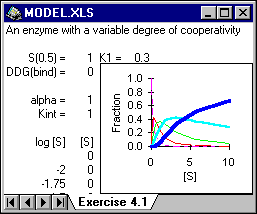These were the exercises in Dynamic Models in Biochemistry. If you can find the book (out of print but perhaps still findable on Amazon.com) they are available to all interested parties (and their students, if any). You may copy and distribute as you wish.
Contact me if you think I can help dbarkley@nsimonco.com
Dynamic Models in Biochemistry
By
Daniel E. Atkinson, University of California, Los Angeles
Steven G. Clarke, University of California, Los Angeles
Douglas C. Rees, California Institute of Technology

The quantitative aspects of biochemistry are often
intimidating to beginning and even some advanced students. Dynamic Models
in Biochemistry takes your
students from an exploration of simple equilibrium relationships (including
acid-base relationships) and enzyme activities to a consideration of the
behavior of polymers and metabolic pathways -- all in a dynamic environment
where the student can interrogate each physical process with both prompted
and independently motivated "what-if" questions.
Students learn how to
- Build models of simple equilibrium and acid-base behavior (including polyprotic
acids).
- Build models of simple Michaelis enzymes as well as enzymes exhibiting cooperative
behavior of varying degrees of complexity.
- Explore the dynamics of metabolism through models of sequential reactions, branch
points, feedback control, etc.
- Build models of passive, facilitated, and active transport across membranes and explore the differing consequences of these transport modes.
- Explore the restrictions on torsion angles that steric hindrance brings to bear
on large molecules and to examine many of the forces that influence macromolecular
structure.
Table of Contents
- CHAPTER 1: Getting Started
- CHAPTER 2: Tips on Using Electronic Spreadsheets
- CHAPTER 3: Equilibrium and Acid-Base Relationships
- CHAPTER 4: Enzyme Kinetics
- CHAPTER 5: Metabolism
- CHAPTER 6: Membrane Transport
- CHAPTER 7: Structure and Stability of Macromolecules
Exercises